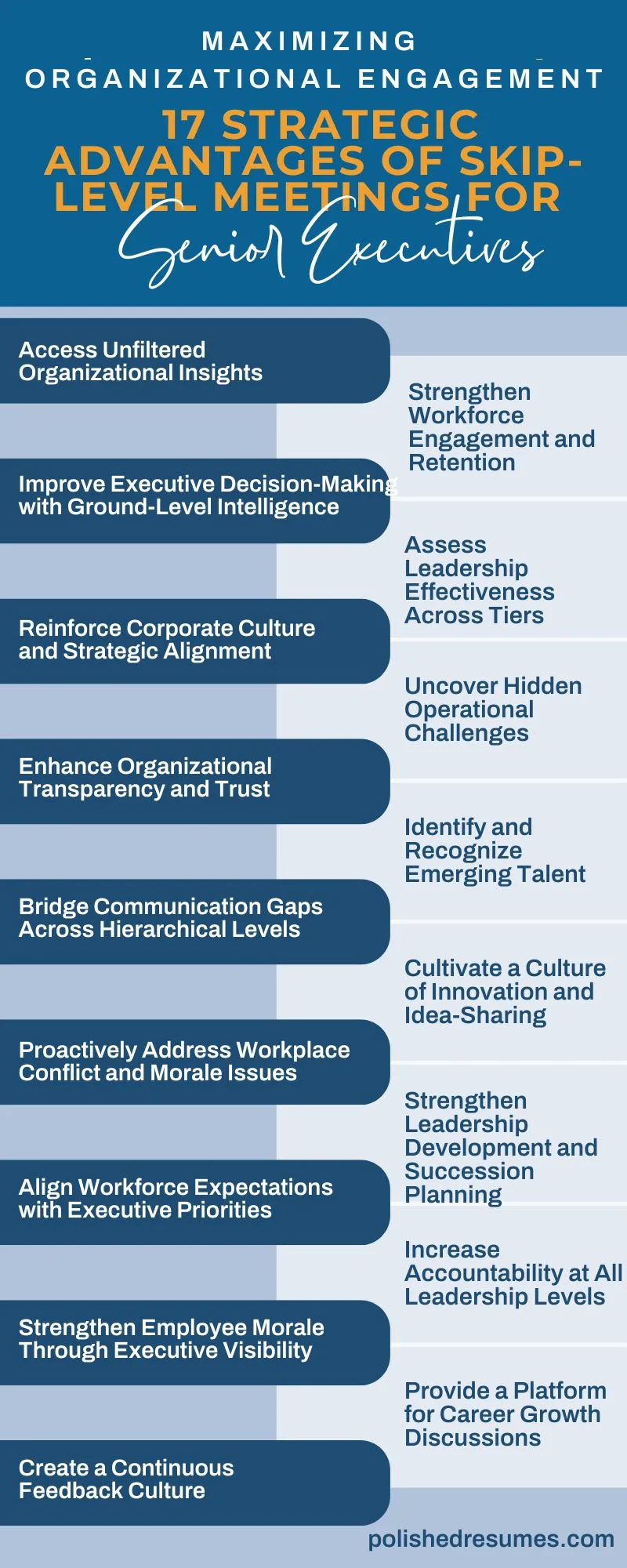by Diane Hudson
In high-performance organizations, senior executives must bridge communication gaps, drive cultural alignment, and ensure leadership effectiveness across all levels. Skip-level meetings—direct interactions between senior leadership and frontline employees—offer a powerful mechanism to enhance engagement, uncover operational insights, and reinforce strategic vision. These meetings bypass traditional reporting structures, enabling executives to gain unfiltered feedback and strengthen workforce trust.

Below is a high-level executive perspective on 17 key advantages of skip-level meetings and how they enhance leadership effectiveness. For a deeper analysis, refer to the full article on Forbes: How to Boost Engagement: 17 Reasons to Have Skip-Level Meetings.
1. Access Unfiltered Organizational Insights
Skip-level meetings provide senior executives with direct visibility into frontline challenges, operational inefficiencies, and leadership effectiveness. These candid interactions help refine strategic decision-making and pre-emptively address emerging risks.
2. Strengthen Workforce Engagement and Retention
Executives who engage directly with employees create a sense of visibility and inclusion, fostering a workplace culture where individuals feel valued and heard. A more engaged workforce leads to lower attrition rates and stronger organizational commitment.
3. Improve Executive Decision-Making with Ground-Level Intelligence
Senior leaders often receive filtered reports from middle management, which can obscure critical insights. Direct access meetings ensure direct access to on-the-ground realities, allowing executives to make informed, data-driven decisions.
4. Assess Leadership Effectiveness Across Tiers
Skip-level meetings provide a platform to evaluate mid-level managers’ leadership capabilities, identifying strengths and areas for development. By listening to employee feedback, executives can proactively address gaps in management effectiveness.
5. Reinforce Corporate Culture and Strategic Alignment
Leaders set the cultural tone for an organization, but maintaining alignment across multiple layers of management is challenging. Direct access meetings help executives reinforce corporate values, mission priorities, and strategic objectives directly with employees.
6. Uncover Hidden Operational Challenges
Employees on the front lines often face process inefficiencies that are invisible at the executive level. Skip-level conversations expose these pain points, empowering leadership to implement effective process improvements.
7. Enhance Organizational Transparency and Trust
By engaging in open, candid discussions with employees, executives build trust and credibility. A transparent leadership approach fosters a culture of accountability and encourages employees to voice concerns before they escalate.
8. Identify and Recognize Emerging Talent
Executives can use skip-level meetings to spot high-potential employees who may not be visible through traditional talent pipelines. Early recognition of emerging leaders supports succession planning and strengthens long-term talent development.
9. Bridge Communication Gaps Across Hierarchical Levels
Silos within an organization can stifle innovation and slow decision-making. Skip-level meetings eliminate layers of miscommunication, ensuring that executives receive direct, accurate feedback from their workforce.
10. Cultivate a Culture of Innovation and Idea-Sharing
Providing employees with direct access to leadership encourages them to share innovative ideas and solutions. Organizations that leverage employee-driven innovation gain a competitive advantage in efficiency, product development, and customer service.
11. Proactively Address Workplace Conflict and Morale Issues
Leadership blind spots regarding team dynamics can lead to unresolved conflicts that disrupt productivity. Direct access meetings allow executives to intervene early, mitigating tensions before they escalate.
12. Strengthen Leadership Development and Succession Planning
Observing employees’ problem-solving skills and strategic thinking in these meetings provides executives with insights into future leadership potential. This real-time talent assessment is invaluable for succession planning.
13. Align Workforce Expectations with Executive Priorities
Senior leaders often set organizational objectives without directly gauging workforce sentiment. Skip-level meetings ensure that employees understand, support, and align with corporate goals, reducing resistance to change.
14. Increase Accountability at All Leadership Levels
Managers are responsible for driving performance, but without direct executive oversight, accountability gaps can arise. Skip-level meetings highlight where leadership support is strong and where interventions are necessary.
15. Strengthen Employee Morale Through Executive Visibility
Employees are more engaged when they feel connected to leadership. Direct interaction with senior executives fosters a sense of purpose, motivation, and appreciation across all levels of the organization.
16. Provide a Platform for Career Growth Discussions
Employees often feel disconnected from executive leadership regarding career growth opportunities. Direct access meetings offer a forum to discuss career development, professional aspirations, and pathways to advancement.
17. Create a Continuous Feedback Culture
By normalizing direct executive-employee conversations, organizations cultivate a workplace where feedback flows seamlessly. This feedback-driven culture supports agility, responsiveness, and continuous improvement.
Final Thoughts
Skip-level meetings are a strategic asset for senior executives seeking to enhance engagement, refine leadership effectiveness, and drive organizational excellence. These conversations unlock valuable insights, build trust, and ensure leadership alignment at all levels. By institutionalizing skip-level meetings, executives can foster a high-performance culture that thrives on transparency, innovation, and strategic cohesion. For a comprehensive breakdown of these strategies, explore the full article in Forbes Magazine.


